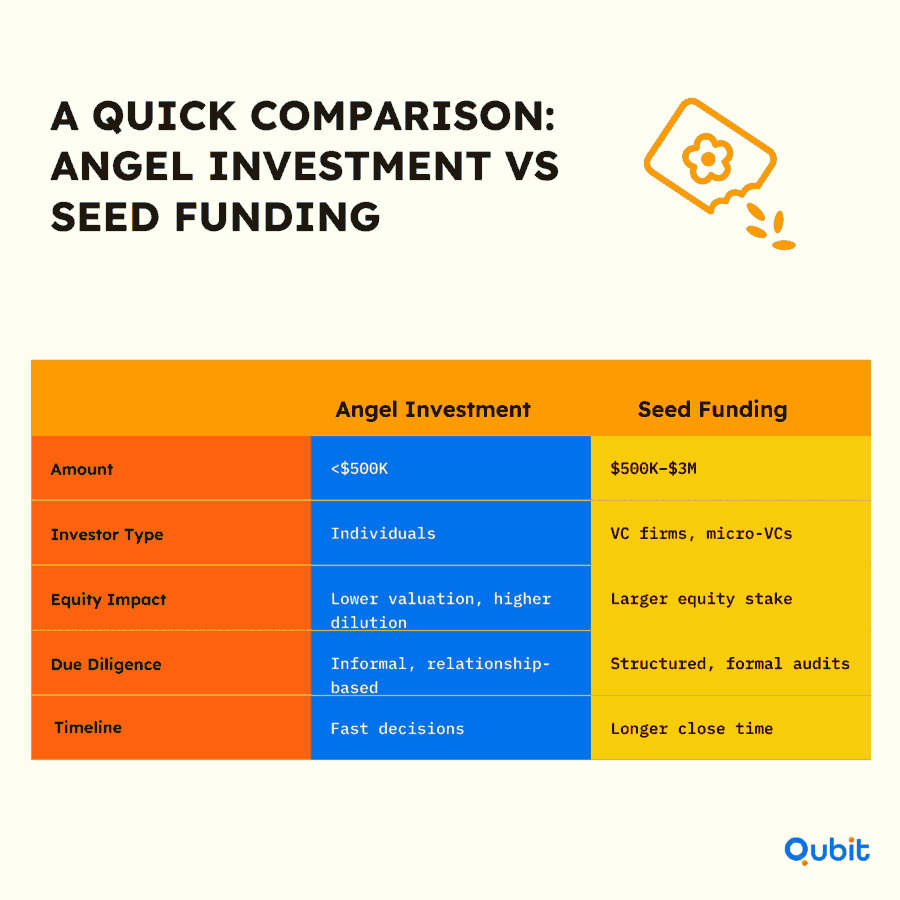For startups aiming to scale, securing early-stage funding is a critical milestone. Two common avenues for raising capital—seed funding and angel investment—are often misunderstood or used interchangeably. While both focus on supporting startups in their infancy, they differ significantly in structure, purpose, and investor expectations. Understanding these distinctions is essential for startups preparing for subsequent funding rounds, such as a series A round of funding, and even later stages like series B funding meaning.
Successfully securing how to get seed funding often requires a structured approach. By exploring the nuances of seed funding and angel investment, startups can make informed decisions that align with their growth strategies and long-term goals, especially when considering funding rounds explained and investment rounds explained.
What is Angel Round Funding
Angel round funding represents the earliest stage of financial support for startups, often provided by individual investors using personal funds. These investments typically fall under $500,000, making them ideal for businesses with limited traction or reputation. Angel investors step in when traditional funding options, such as bank loans or venture capital, may not be accessible due to the startup’s infancy.
Advantages of Angel Funding
Angel investors offer more than just capital—they bring flexibility and mentorship to the table. Unlike institutional investors, angels often make rapid decisions, allowing startups to secure funding without prolonged negotiations. Additionally, these investors may provide valuable industry insights and connections, helping founders refine their strategies and scale operations.
Another benefit is the relatively low equity loss compared to later funding stages, such as the series A round of funding. Since angel rounds are smaller in scale, startups can retain significant ownership while still gaining the resources they need to grow.
Disadvantages to Consider
While angel funding can be a lifeline for early-stage startups, it’s not without drawbacks. Accepting capital at a low valuation often means giving up equity that could be worth much more in the future. This can limit the founder’s control as the business grows.
Additionally, the smaller investment size may not provide a sufficient runway for ambitious growth plans. Startups relying solely on angel funding might find themselves needing additional rounds of funding sooner than anticipated.
For a broader perspective on other funding options, explore the types of startup funding, which detail the unique benefits and challenges of various approaches.
Angel funding is a pivotal step for startups, but understanding its nuances is essential for long-term success.
What is Seed Round Funding?
Seed funding plays a pivotal role in helping startups transition from concept to execution. Thought for a few seconds
Understanding what is seed funding is the foundation for exploring its role in early-stage startup growth. Typically ranging between $500K and $3M, this funding round enables businesses to validate their products, enhance marketing efforts, and secure early customer traction.
Advantages of Seed Funding
Seed funding provides startups with the capital necessary to build momentum. With access to larger investments compared to earlier funding rounds, businesses can refine their products and expand their market presence. This stage also introduces startups to a diverse investor base, including micro-VCs, which can offer valuable guidance and industry connections.
Moreover, seed funding is instrumental in demonstrating market viability. By achieving measurable milestones, startups can position themselves as strong candidates for subsequent funding rounds, such as Series A.
Challenges of Seed Funding
Despite its benefits, seed funding comes with its own set of challenges. Startups often need to relinquish a larger equity share to attract investors, which can dilute ownership. Additionally, the expectations from investors at this stage are higher, as they anticipate clear evidence of product-market fit and early traction.
Balancing growth with investor demands can be daunting, especially for founders new to the fundraising process. The pressure to meet milestones and deliver results can strain resources, making it essential to have a well-structured plan in place.
Seed funding is a critical phase that sets the foundation for scaling operations and securing future investment rounds. While it provides the financial resources to grow, startups must weigh the trade-offs carefully to ensure long-term success.
Comparing Angel and Seed Rounds: What's the Differences?

Securing early-stage funding is pivotal for startups, but understanding the nuances between angel and seed rounds can shape your strategy. Angel rounds typically involve individual investors contributing smaller amounts, often under $500K. These investments come with lighter due diligence, as angel investors often prioritize personal relationships and potential over rigorous scrutiny.
Seed rounds, on the other hand, are more structured and can raise up to $3M. Institutional investors or venture capital firms often participate, demanding extensive due diligence. Equity stakes in seed rounds are generally larger, reflecting the higher investment size and risk involved.
The funding timelines also differ. Angel rounds can close quickly due to informal processes, while seed rounds may take months as investors evaluate business models and market potential. These early stages pave the way for later investment rounds, where startups aim for substantial capital to scale operations.
Understanding these distinctions is essential for aligning your funding strategy with growth objectives. Whether seeking flexibility or structured support, choosing the right round can significantly impact your startup’s trajectory.
In-Depth Funding Round Analysis
Understanding funding rounds is essential for startups aiming to scale effectively. These rounds represent distinct stages in a company’s growth journey, where external capital is raised to fuel operations, product development, or market expansion. Each funding round—from angel investments to Series A and beyond—serves a unique purpose, aligning with the company’s maturity and investor expectations.
1. Key Definitions and Startup Stages
Funding rounds are categorized based on the startup’s lifecycle. Early-stage rounds, such as angel and seed funding, focus on validating ideas and achieving product-market fit. For example, Ola Cabs secured ₹1 crore in angel investment from Rehan Yar Khan and Anupam Mittal, enabling them to expedite their entry into the ride-hailing market. This initial funding laid the groundwork for their eventual $210M Series A, led by SoftBank, delivering a remarkable 40.7x ROI to early investors.
As startups progress, Series A rounds of funding typically aim to scale proven business models. Investors prioritize traction and growth rates during this stage, as highlighted in the Two Laws Of Startup Physics. These laws underscore how growth metrics guide decisions about funding progression, ensuring resources are allocated to scalable opportunities.
2. Investor Profiles and Investment Amounts
Investor involvement evolves with each funding stage. Angel investors and seed funds often focus on high-risk, high-reward opportunities, while venture capitalists dominate Series A and subsequent rounds. Investment amounts vary significantly, with early rounds often ranging from $100K to $2M, and Series A funding typically exceeding $10M.
3. Due Diligence and Timelines
Due diligence becomes increasingly rigorous as startups mature. Early-stage rounds may involve informal evaluations, whereas Series A and beyond require formalized processes, including financial audits, market analysis, and legal reviews. Timelines also shift; while angel funding can be secured in weeks, later rounds may take months due to heightened scrutiny.
4. The Role of Technical Expertise
Technical expertise plays a pivotal role in early-stage funding. Startups with robust technical foundations often attract investors seeking scalable solutions. By understanding the nuances of funding rounds and having investment rounds explained thoroughly, startups can strategically position themselves for success, ensuring they meet investor expectations at every stage.
How Angel Investors vs. Pre-Seed Venture Capitalists Differ?
Early-stage funding is a critical decision point for startups, and understanding the distinctions between angel investors and pre-seed venture capital firms can shape your approach. Both play vital roles in helping startups secure initial capital, but their methods, support structures, and equity considerations differ significantly.
Angel Investors: Personalized and Flexible
Angel investors are individuals who use their personal funds to invest in startups. Their approach is often more informal, focusing on smaller investment amounts and quicker decision-making. This flexibility can be a lifeline for founders seeking immediate capital without navigating complex processes. Angels often prioritize relationships and may offer mentorship based on their own entrepreneurial experiences.
However, the trade-off for this flexibility is often a higher equity stake. Angel investors typically seek substantial returns on their investments, which can result in founders giving up more ownership early on. For startups preparing for larger funding rounds, such as a Series A round of funding, this early dilution could impact long-term equity distribution.
Pre-Seed Venture Capital: Structured and Scalable
Pre-seed venture capital firms, on the other hand, operate with a more formalized structure. These firms pool funds from multiple investors, enabling them to offer larger capital injections compared to individual angels. Their evaluation process is rigorous, often requiring startups to present detailed plans and projections. Using tools like the Business Plan Generator can help founders craft concise business plans that pre-seed VCs can assess swiftly.
In addition to funding, pre-seed VCs provide strategic guidance and access to networks, which can accelerate growth. While their equity demands may be lower than those of angel investors, the structured process may feel less personal and more transactional.
Choosing and Approaching the Right Funding Option for Your Startup
Determining the best funding path for your startup requires a clear understanding of your current stage and future goals. Angel investors and pre-seed venture capital firms offer distinct advantages, but choosing the right option can set the foundation for a seamless transition to a Series A round of funding.

Strategies for Approaching Angel Investors
- Build Personal Connections
Angel investors often invest in founders they trust. Attend networking events, industry meetups, and startup showcases to establish relationships. A warm introduction through mutual contacts can significantly improve your chances of securing funding. - Highlight Your Vision
Angels are drawn to compelling narratives. Focus on your startup’s mission, the problem you’re solving, and the impact you aim to create. While financial details are important, your passion and vision can be the deciding factor. - Keep It Simple
Avoid overwhelming angel investors with excessive data. Present a concise pitch that emphasizes your unique value proposition, market opportunity, and how their investment will drive growth.
Approaching Pre-Seed Venture Capital Firms
- Prepare Comprehensive Materials
Pre-seed VCs expect detailed documentation. Create a professional pitch deck, term sheet, and financial projections that demonstrate your startup’s potential for scalability. - Target the Right Firms
Research firms that have invested in startups within your industry or niche. Tailor your pitch to align with their investment thesis and strategic goals. - Leverage Referrals
A referral from a trusted source can open doors to pre-seed VCs. Engage with mentors, advisors, or industry experts who can introduce you to relevant firms.
Conclusion
Securing funding is a pivotal step in your startup’s journey, and understanding the nuances between angel and seed funding can make all the difference. From evaluating the flexibility of angel investors to the structured approach of seed funding, aligning your strategy with your business’s growth stage is essential. Each funding type offers unique advantages, but the key lies in meeting investor expectations while ensuring your startup’s long-term goals remain intact.
If you’re ready to take the next step in securing your startup’s funding, we at Qubit Capital are here to support you. Our Fundraising Assistance service can help you navigate the complexities of early-stage funding—let’s get started.
Key Takeaways
- Angel funding is typically smaller and more flexible, suitable for very early-stage startups.
- Seed funding provides a larger capital infusion necessary for scaling and market validation.
- Distinct differences exist in investor profiles, equity stakes, and due diligence processes between the two rounds.
- Understanding your startup’s stage is crucial for choosing the right funding option.
- Effective networking and tailored approaches to investors can significantly boost your funding success.
Frequently asked Questions
What are the four rounds of funding?
The four rounds typically include pre-seed, angel (or seed), seed, and Series A rounds. Each stage builds upon the previous one, offering increasing capital and requiring more rigorous investor scrutiny.


 Back
Back



